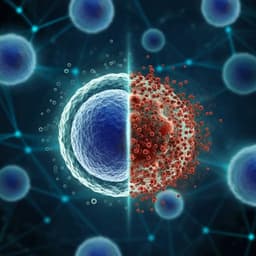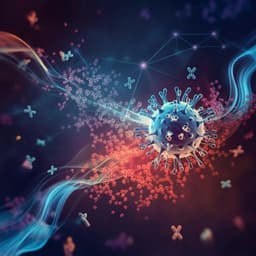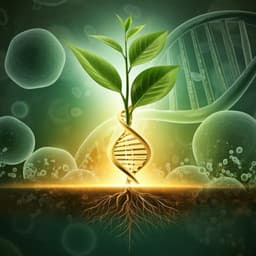
Food Science and Technology
Calcium-rich dairy matrix protects better than mineral calcium against colonic luminal haem-induced alterations in male rats
M. Olier, N. Naud, et al.
Explore how dietary calcium, derived from either calcium salts or dairy, can counteract gut disruptions caused by high iron intakes. This study reveals the innovative potential of dairy-derived calcium in promoting gut health while highlighting concerns associated with hemoglobin-enriched diets. Discover these insights from the research conducted by Maïwenn Olier, Nathalie Naud, Edwin Fouché, and their colleagues.
~3 min • Beginner • English
Introduction
Epidemiological evidence from WCRF/AICR and IARC indicates that lifestyle and diet are major modifiable risk factors for colorectal cancer (CRC), with red meat consumption contributing to increased risk. Heme iron (from haemoglobin) in red meat is implicated as a key promoter of CRC through catalysis of lipid peroxidation of dietary polyunsaturated fatty acids in the colon, generating reactive aldehydes (e.g., 4-HNE) that drive oxidative stress, cytotoxicity, genotoxicity, barrier defects, and preneoplastic lesions. Prior rodent work shows that calcium can mitigate haem-induced promotion of carcinogenesis by reducing luminal haem bioavailability. This study tests the hypothesis that dietary calcium’s protective efficacy depends on its source, comparing mineral calcium salts versus a calcium-rich dairy matrix, and examines cross-impacts of iron form (haemoglobin vs ferric citrate) and calcium source on colonic redox state, barrier homeostasis, and microbiota.
Literature Review
- Red meat is classified as probably carcinogenic (IARC Group 2A) with dose–response associations to CRC; modeling suggests ~5% of CRC cases may be attributable to red meat intake, and many individuals exceed recommended intakes.
- Mechanistic and preclinical data implicate heme iron in promoting a pro-oxidative colonic environment via lipid peroxidation and aldehyde formation (e.g., 4-HNE), contributing to mucosal damage and carcinogenesis. Microbiota modulate haem bioavailability and lipid peroxidation.
- In vitro, calcium salts (e.g., calcium phosphate, calcium carbonate) precipitate haem compounds; in vivo they reduce haem solubility in faecal water without changing total faecal haem, thereby limiting luminal bioavailability and alleviating lipoperoxidation and dysbiosis, with protection against carcinogenesis in rodents.
- Dairy products are major calcium sources. Epidemiological meta-analyses suggest total dairy, milk, cheese, yogurts, and dairy calcium associate with lower CRC risk or adenomas; rodent studies report protective effects of dairy-derived calcium or nonfat dried milk. Potential mechanisms include calcium-sensing receptor signaling, precipitation of fatty/bile acids reducing luminal toxicity, and bioactive dairy proteins/peptides with antioxidant or iron-complexing properties; casein phosphopeptides may enhance calcium bioavailability.
- Prior haem models used haemin or haemoglobin; effects on microbiota and mucosa can differ by haem form and dose, suggesting the need to evaluate calcium source effects in a haemoglobin model.
Methodology
Design and animals: Male Fischer 344 rats (F344/DuCrl; n=48; 6 weeks old) were housed at 22°C on a 12-h light–dark cycle and fed ad libitum. Protocol approved by the Comité d'Ethique Pharmacologie-Toxicologie-Occitanie Toulouse (#16138-TOXCOM 214FP) in accordance with EU guidelines.
Diets and factorial design: All semi-purified powdered diets were based on AIN-76A adapted to minimize calcium (0.09%). A 2×3 factorial design tested iron form (ferric citrate vs haemoglobin as a proxy for red meat) and calcium content/source (Control low Ca vs Mineral Calcium vs Dairy Calcium). Control diets contained 22.5 µmol Ca/g; Mineral Calcium and Dairy Calcium diets contained 118 µmol Ca/g (via Ca-phosphate for Mineral; via a dairy matrix for Dairy). Diets were balanced in iron, protein, and lipids except for calcium. The dairy matrix was produced from pasteurized whole milk concentrated by ultrafiltration, with added calcium phosphate and rennet to form cheeses; composition: pH 6.47; dry matter 43.6%; lipids 18%; proteins 15.0%; calcium 1.3%. Additional diet components included safflower oil and butter as specified; see Table 1 in paper for full composition.
Intervention and sampling: After a 7-day acclimation on ferric citrate Control diet, rats were randomized into six groups (n=8/group) and fed assigned diets for 23 days. Body weight, food and water intake were tracked weekly. One week before sacrifice, 24-h urine and feces were collected in metabolic cages.
Biomarker assays: Faecal waters were prepared with distilled water plus BHT; haem and TBARS were quantified (standard methods). Urinary DHN-MA (a 4-HNE metabolite) was measured by competitive enzyme immunoassay.
Barrier function and histology: Intestinal paracellular permeability was assessed as percent urinary excretion of orally administered 51Cr-EDTA over 24 h. Colonic segments were fixed, paraffin-embedded, and H&E-stained for histology.
Mucosal gene expression: RNA from frozen mucosa was extracted; cDNA prepared and qPCR performed (SYBR Green) for genes related to haem catabolism (e.g., Hmox1), inflammation (e.g., IL-18), detoxification (e.g., Slc7a11, Akr1b8, Aldh3A2), and barrier function; normalized to POLR2A; analyzed with LinRegPCR.
Microbiota profiling: Genomic DNA from feces was extracted; V3–V4 16S rRNA regions were amplified and sequenced (Illumina MiSeq). Reads were processed with FROGS: filtering, merging, clustering (swarm), chimera removal, prevalence/abundance filtering, yielding 486 OTUs; taxonomy assigned using Silva 138.1. Samples with <15,000 valid sequences were excluded; depths normalized to 21,350 reads. OTUs were agglomerated to family (46 taxa) and species ranks (144 taxa) for analyses.
Bioinformatics and statistics: Alpha diversity (Chao-1 richness, Simpson evenness) and beta diversity (UniFrac distances; multidimensional scaling) were computed with Phyloseq. Beta-diversity differences tested by Adonis (9999 permutations) with pairwise multilevel comparisons. Differential taxa identified by LEfSe (KW p<0.05 or 0.01, q<0.05, LDA score ≥3). Data integration of microbiota families (46) with physiological variables (38) used MixOmics PLS1; relevance networks visualized correlations ≥0.62. Other variables analyzed by two-way ANOVA (factors: iron, calcium, interaction) with Holm–Šídák’s post-tests; significance at p≤0.05.
Key Findings
- General: Body weight gain over 3 weeks was not affected by diet composition.
Luminal haem bioavailability and oxidative stress:
- In Control (low-calcium) diets, haemoglobin vs ferric citrate increased haem in faecal water (Firon=36.9, Piron<0.0001; Padj Control<0.0001), elevated mucosal Hmox1 expression (Firon=16.2, Piron=0.003; Padj Control<0.0001), and increased faecal TBARS (Firon=34.7, Piron<0.0001) and urinary DHN-MA (Firon=20.1, Piron<0.001; Padj Control=0.007), indicating heightened luminal lipoperoxidation and systemic absorption of aldehydes.
- Adding calcium (Mineral or Dairy) reduced haem detection in faecal water regardless of iron form (Fcalcium=12.2, Pcalcium<0.0001), with more efficient haem trapping by dairy matrix than mineral calcium (haemoglobin vs ferric citrate comparison: Padj Mineral Ca=0.0081; Padj Dairy Ca=0.05). Calcium addition abolished haem-induced Hmox1 upregulation (Fcalcium=32.6, Pcalcium<0.0001; haemoglobin vs ferric citrate Padj Mineral/Dairy>0.05). TBARS and DHN-MA increases with haemoglobin were attenuated by calcium, and were fully prevented when calcium came from the dairy matrix (TBARS/DHN-MA: haemoglobin vs ferric citrate Padj Mineral Ca<0.001; Padj Dairy Ca>0.05).
Barrier function and mucosal genes:
- Haemoglobin vs ferric citrate did not significantly affect 51Cr-EDTA permeability or mucosal expression of IL-18, Slc7a11, Akr1b8 (Firon≈2; Piron>0.05) nor histologic architecture.
- Calcium improved barrier function and reduced inflammation/detoxification gene expression regardless of iron form (Fcalcium>3.4, Pcalcium<0.05 for permeability, IL-18, Akr1b8; Fcalcium=9.3, Pcalcium<0.01 for Slc7a11), with a trend toward greater improvement for dairy calcium.
Microbiota diversity and composition:
- Alpha-diversity: Not affected by iron form (Firon=0.5, Piron>0.05). Modulated by calcium amount and source: richness (Chao-1) increased with mineral calcium (Fcalcium=4.5, Pcalcium<0.05); evenness (Simpson) decreased with dairy calcium (Fcalcium=11, Pcalcium<0.01).
- Beta-diversity: Strong separation primarily by calcium source/amount (Unifrac: Fcalcium=7.3, Pcalcium<0.0001). Iron-dependent separation observed in Control diets (Padj Control=0.01) diminished when calcium was added (Padj Mineral/Dairy>0.05).
- Phyla-level shifts (Bacteroidota, Firmicutes, Actinobacteriota) were influenced by both iron and calcium, with haemoglobin-induced changes in Control diets being alleviated by calcium regardless of source (Firon×calcium>6, Piron×calcium<0.01).
Integrated microbiota–phenotype associations:
- PLS network (correlations ≥0.62) linked higher luminal haem bioavailability and lipoperoxidation markers (faecal haem, Hmox1, TBARS, urinary DHN-MA) positively with Eubacterium coprostanoligenes group, Muribaculaceae, and Peptococcaceae, and negatively with Bifidobacteriaceae (inverse association with TBARS). Calcium addition mitigated haemoglobin-driven shifts in these taxa irrespective of source.
Taxa-level normalization by calcium source:
- Haemoglobin-altered Eisenbergiella spp. and multi-affiliated Lachnospiraceae were normalized by both calcium sources.
- Bifidobacterium pseudolongum and Lachnoclostridium were preferentially normalized by mineral calcium; unknown Peptococcaceae and Lactobacillus intestinalis were preferentially normalized by dairy calcium.
- Some haemoglobin-affected communities were not restored by calcium; other taxa (e.g., Desulfovibrio spp., unclassified Enterococcus, Negativibacillus spp.) were modulated by calcium independent of iron. Certain taxa (Frisingicoccus caecimuris, Macrococcus spp., Exigobacterium spp.) appeared only in dairy matrix diets.
Overall outcome: Dairy matrix calcium more effectively reduced luminal haem iron bioavailability and prevented haemoglobin-induced lipoperoxidation than mineral calcium, alongside broader modulation of microbiota and modest improvements in barrier-related indices.
Discussion
The study addressed whether calcium’s protection against haem-driven colonic perturbations depends on source. In this haemoglobin-based rat model, haem iron increased luminal bioavailable haem and lipid peroxidation, elevating Hmox1, TBARS, and DHN-MA, and reshaping microbiota. Supplementing calcium limited haem bioavailability and attenuated oxidative markers, with the dairy matrix outperforming mineral calcium by fully preventing haem-induced increases in TBARS and DHN-MA and abolishing Hmox1 induction. Despite pronounced luminal redox effects, haemoglobin did not impair barrier permeability or inflammation/detoxification gene expression under the conditions used, differing from prior haemin-based models—likely due to lower haem exposure and differences between haem forms.
Calcium’s benefits likely extend beyond CaSR-mediated epithelial signaling to luminal actions: precipitating haem and free fatty/bile acids, reducing solubility and toxicity. The superior efficacy of dairy calcium may involve dairy matrix components (proteins, bioactive peptides) with antioxidant and iron-binding properties, and casein phosphopeptides enhancing calcium luminal bioavailability, thereby improving haem trapping. Microbiota analyses reinforced that calcium curtails haem-associated dysbiosis; correlations connected haem/lipoperoxidation to Peptococcaceae and Eubacterium coprostanoligenes group, while Bifidobacteriaceae associated inversely with TBARS. Source-dependent normalization of specific taxa (e.g., mineral favoring B. pseudolongum, dairy favoring L. intestinalis and Peptococcaceae reduction) suggests distinct microenvironmental effects of calcium sources. Collectively, findings support dietary recommendations emphasizing food-based, particularly dairy, calcium to mitigate red meat–related colonic oxidative stress and microbiota dysbiosis, potentially lowering CRC promotion risk.
Conclusion
Dietary calcium reduced luminal haem iron bioavailability and blunted haemoglobin-induced colonic lipoperoxidation in rats, with calcium delivered in a dairy matrix conferring greater protection than mineral calcium salts. Calcium supplementation also improved barrier-related indices and reshaped microbiota away from haem-associated dysbiosis, with source-dependent effects on specific taxa. These results highlight the importance of nutrient source and matrix in modulating iron–calcium interactions, luminal redox balance, and microbiota. Future work should delineate mechanisms underlying dairy matrix superiority (e.g., protein/peptide-mediated antioxidant and iron-binding actions, casein phosphopeptides), assess long-term outcomes including carcinogenesis endpoints, and evaluate translation to humans to refine dietary guidance for CRC prevention.
Limitations
- Short-term (23-day) intervention without long-term carcinogenesis endpoints; effects on tumor incidence were not assessed.
- Rat model limits direct extrapolation to humans; sex-specific effects were not explored (male rats only).
- Differences from prior haemin models indicate outcomes depend on haem form and dose; generalizability across red meat exposures may vary.
- Some haemoglobin-altered bacterial communities were not restored by calcium, and biological implications of dairy-exclusive taxa were not functionally validated.
- The dairy matrix contains multiple components; the specific contributors to enhanced protection (calcium bioavailability, proteins/peptides, other factors) were not isolated.
- Barrier function improvements with dairy calcium showed trends but were not always statistically superior to mineral calcium.
Related Publications
Explore these studies to deepen your understanding of the subject.







